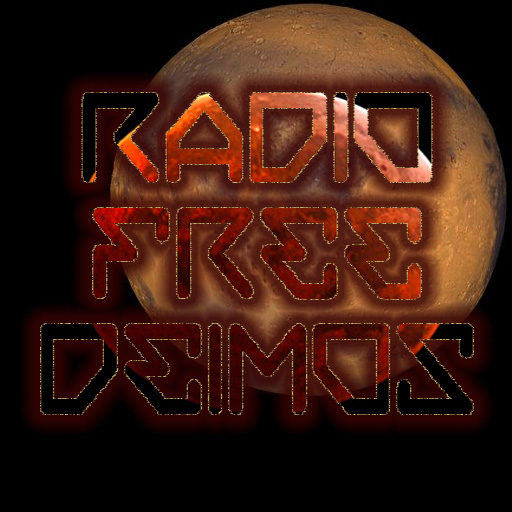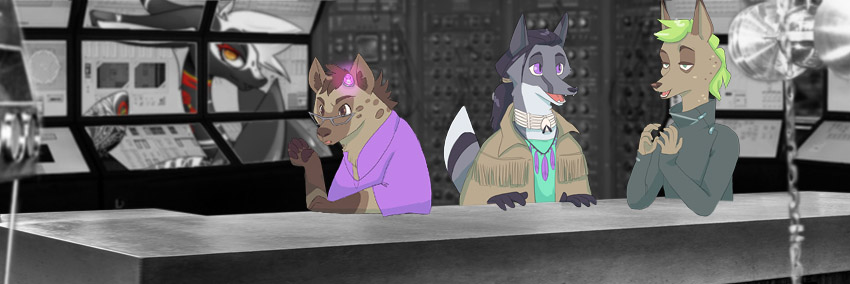The Deimos chamber of commerce and tourism invites visitors to our new bowling alley and lounge. The newly opened Bowlmore has three lanes and extends fully 2% of the width of the moon, but that’s not saying much.
Episode 20, Hot Zones! Hc Svnt Dracones author Pierce Fraser unpacks the concept for us in a lorebook-spoiler-packed interview, and the hosts chew on the topic for an hour…
Show notes coming soon!
♃ 0.00 — Here’s the HSD Lorebook Kickstarter, now past goal!
♃ 3.10 — Pierce lovingly unboxes a ‘taur.
♃ 13.15 — There is a time period, 200 years after the end of earth or so, where the free market was gradually hedged out in favor of the MarsCo/Big Six oligarchy. In all likelyhood, this was the backdrop for the birth of Spyglass AND IRPF. Hmm.
♃ 14.50 — The concept of “shadow war” is a new one for the upcoming Lorebook, a sustained and hidden off-planet (or at least very isolate) war between megacorps, like a hotzone but on a larger, longer scale.
♃ 18.29 — given that MarsCo spun off IRPF to enforce the hotzone system, this kind of clinches MarsCo as the big spider in the center of the Sol web. And seriously throws into question the idea of the “free market” having any real meaning in HSD.
♃ 20.22 — Out of the entire interview, this bit about “the corps are governing, they don’t need to enslave people like dictators because the technology does it for them…” is my favorite. As Ashtaar says later, it really emphasizes that this is only a utopian setting at its surface.
♃ 23.37 — Lumen spoilers! Lightspeed technology brought to you by a disruptive startup 🙂
♃ 25.46 — see 13.15, some more suggestion that there was a period of market freedom that didn’t survive MarsCo’s consolidation of the corporate power structure some 100-300 years AE.
♃ 27.10 — Nice spin! After the rules for hotzones were put into place, IRPF, a MarsCo spinoff, became popular hometown hero types for enforcing the rules of hot zones. You COULD read this more positively, that the hot zone system was created to add order to a battlefield, but that’s not the tone I’m getting.
♃ 29.10 — A few points on the limits of a hot zone: one of the biggest is the morale (use HSD’s Nerve system if you wish.) A hot zone only extends to the limit that the employees and citizens of a corp area can sustain it. Management can push to greater violence, but the check and balance here is that a ruthless corporate structure is likely to lose its “military” force, particularly when the risks to the individual outweigh the benefits. Remember that there isn’t a line between “Employee” and “citizen” in larger corporate structures. Vectors fighting for their homes and their way of life may have stronger nerve than mercenaries, and employees of a hostile may convince themselves that there’s an easier way. Theoretically since the power level of corps in a hot zone situation should be on the same general level, it’d be harder to engage in shock and awe tactics to make the smaller corp scatter, but that’s only to whatever degree the rules are enforced locally. Expect the landscape to be tilted toward whomever the highest level corporation in the area favors.
♃ 30.00 — HSD may encourage violence with the hotzone concept, and TRPGs in general tend to lean on combat as a way of building energy (it’s a safe statement, your table may vary.) However, HSD generally doesn’t encourage killing. Rather than risk their lovely baristas, Starbarks is more likely to contract a small mercenary group (read: PCs) to fight their battles, and this is a good way to introduce and sustain a recurring rival NPC team.
♃ 36.00 — Sammi and Sev’s playtest sessions are mostly on YouTube and a few other streaming services. I’m slowly working through them (they’re playing faster than I’m reviewing.) Session #4 originally got me interested in the hot zone concept and was the seed for this episode.
♃ 36.45 — Reference here to Naomi Kline’s “Shock Doctrine.” According to Kline, the “free market” is a concept used to rip resources out of smaller countries and public hands during times of disaster and crisis. There’s a really great summary on the “Beautiful Trouble” blog.
♃ 38.30 — Back to our conversation about debt in the economy episode. On Ext1.0p.61 HSD discusses the concept of crippling corp-created debt. Companies that exploited their workers by sending them into debt death spirals create their own liabilities in HSD, as other more “generous” companies can liberate distressed workers and, I believe, acquire the protection and influence of their inherited portfolios. It’s to the benefit of a corporation to find a balance between subsistence and contentment for their employee-citizens.
♃ 41.40 — short discussion of the size and scale of a standard hot zone here, from “across the street” to “across the city.”
♃ 42.18 — There’s a note in ASR’s corporate description that says ASR is one of the only corps to have more than one corpernation. I’ve been using that word incorrectly for some time now…it describes an area dominated by a single corporation that’s the size of a planet, or in some cases a small moon. There aren’t many of them and they don’t seem to be fashionable these days.
♃ 43.06 — Another resource that informed this discussion is Richard Norton’s speculative monograph, “Feral Cities.” While a bit overstated for hot zones in the Rules As Written, in a worst-case scenario, the concept of a megalopolis with an infrastructure that’s utterly collapsed and been replaced by ad-hoc local arrangements, the corrupt remnants of government, and a criminal underworld-turned-overlord could make a strong story. Because of the breakdown of the service sector and infrastructure, the area becomes even more lawless, and plague/disease/ecohorror plotlines become possible, even within the generous constraints of Progenitus panimmunity treatments. It may even be possible to have plots where the ledger, buyspot, and toggle systems have broken down. A disruption of the ledger would fundamentally break vector society in that area. A breakdown of this level isn’t supported by the rulebook. Ashtaar suggests it might more easily take place on a grotto or space station.
♃ 47.55 — Based on Norton’s classification of feral cities, possible classifications of a hot zone: a green hot zone hasn’t broken into violence, but as described in the core rulebook (HSD1.0p.58) the hotzone is a simmering and volatile area where tempers flare, an area on the edge of a riot. Yellow hotzones might be a situation where open warfare has broken out, hostile agents might be detained by merc forces or employees, and the average citizen will want very much to stay indoors. Red hotzones might be the full breakdown we discussed in this episode, not supported by RAW but a logical extreme.
♃ 50.40 — I was trying to suggest here that disease plotlines in poorer areas might be possible. “Poverty” and “a proactive approach to health care” simply don’t go together (at least from personal experience) as you really can’t pay for tomorrow when you can’t afford today. Sooo much of HSD’s world assumes a level of prosperity, but vectors doPowerkill “game”/thought experiment. Corbeau mentiones John Tynes, take two drinks. I bring it up purely to bring up his concept of FAE, “Fun And Excitement,” the energy brought to the surface by glorifying violence and crime with the trappings of heroic fantasy. Every time I use the phrase “fun and excitement,” I’m referencing this one, and I use it a lot. I think Ashtaar took this as a bit more of an attack than it was meant to be, we’d been recording for almost two hours at this point and we were starting to wear out.
♃ 1.06.40 — For the record, the 2006 World Cup Death Watch on WFMU was 79, not 40…
♃ 1.07.16 — Second attempt to wrap up the discussion by looking at hotzones as they might be implemented by some of the big seven. I think I forgot ASR, they’re tricky because I’ve never had a clear grasp of what differentiates ASR flavor-wise from MarsCo. I’d imagine the hotzone would be heavily surveiled, and it’d be almost impossible to avoid huge property damage fees with all the tech embedded in the urban area. Pulse, I think, would be likely to have roving reporters and cameramen, and it seems like they’d likely embed celebrities in the zone to give them exciting new terrain to show their augmented muscles off in. The high point of a Pulse combat zone though would be that if you gave the stirring speech to rouse the crowd, it’d be played hundreds of times over SolNet.
♃ 1.19.45 — Ashtaar theorizes here that TTI likely doesn’t involve themselves much in hotzones, because they’re more focused on the Alien Threat than political nonsense. I don’t think the text necessarily backs that up, but it’s an angle you could easily spin in your story.
♃ 1.22.11 — The hosts speculate on IRPF hot zones. Technically, since they have no corptowns, they really can’t have a true “hotzone” situation, but there may be parallel conflicts…infighting, resource allocations, and so on…
1.25.38 — Likewise, we’re not sure about a hotzone in a Spyglass area. The answer we think is categorically “no,” mostly because Spyglass doesn’t mind more direct ways of handling conflict.
With thanks to Sirius Beat for our intro music, “Future Club,” and outro music, “Tronicles.” Our fun, modular header art is by Absyfield , (Thank you Ashley!) and Whines is our audio engineer.
Podcast: Play in new window | Download
Subscribe: RSS

